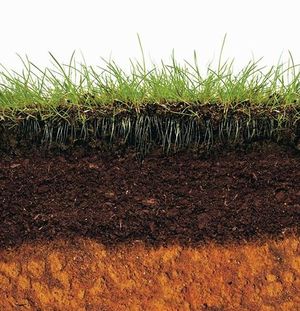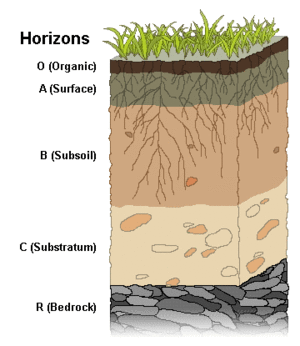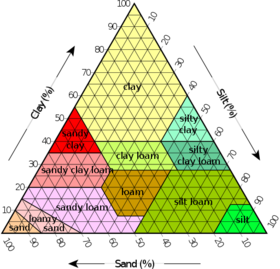Soil: Difference between revisions
No edit summary |
No edit summary |
||
| Line 19: | Line 19: | ||
Soil is typically 50% pores half/half occupied with water and gas, and solids like minerals or organic matter. [11] The pore space allows for the infiltration and movement of air and water, both of which are critical for life in soil. [12] Compaction creates problems for this. | Soil is typically 50% pores half/half occupied with water and gas, and solids like minerals or organic matter. [11] The pore space allows for the infiltration and movement of air and water, both of which are critical for life in soil. [12] Compaction creates problems for this. | ||
Over time, soil will develop a soil profile which consists of multiple layers or [[soil | Over time, soil will develop a soil profile which consists of multiple layers or [[soil Horizons]] that differ in one or more [[properties]] ([[Soil Textures|texture]], structure, porosity, density, etc.). [13] They differ in thickness and don’t exhibit hard boundaries. The formation of these layers is reliant on the parent material, the modification processes of the parent materials, and soil forming factors that influence those processes. The biological influences on soil [[properties]] are strongest near the surface, while the geochemical influences on soil [[properties]] increase with depth. | ||
The [[soil texture]] is determined by the relative proportions of the individual particles of [[sand]], [[silt]], and [[clay]] that make up the soil. The interaction of the individual mineral particles with organic matter, water, gases via biotic and abiotic processes causes those particles to flocculate (stick together) to form aggregates or peds. [14] Where these [[Aggregate formation|aggregates]] can be identified, a soil can be said to be developed, and can be described further in terms of color, porosity, consistency, reaction (acidity), etc. [[File:USDA_Soil_Texture.png|280px|thumb|right|USDA Soil Texture Triangle [21]]] | The [[soil texture]] is determined by the relative proportions of the individual particles of [[sand]], [[silt]], and [[clay]] that make up the soil. The interaction of the individual mineral particles with organic matter, water, gases via biotic and abiotic processes causes those particles to flocculate (stick together) to form aggregates or peds. [14] Where these [[Aggregate formation|aggregates]] can be identified, a soil can be said to be developed, and can be described further in terms of color, porosity, consistency, reaction (acidity), etc. [[File:USDA_Soil_Texture.png|280px|thumb|right|USDA Soil Texture Triangle [21]]] | ||
Revision as of 14:21, 10 April 2021

Soil is a mixture of minerals, liquids, gases, organisms, and organic matter that when together can support life. The Earth’s soil is called the pedosphere, which has 4 main functions: it is a means of water storage, purification and supply; it is a medium for plant growth; it is habitat for organisms that modify the soil; it is a modifier of Earth’s atmosphere.
Things like the lithosphere, the atmosphere, the biosphere, and the hydrosphere interact with soil. In soil there is a solid phase of organic matter and minerals, as well as a water and gas holding porous phase. [1,2,3] Soils are sometimes treated as a 3-state system of solid, liquids, and gases.[4]
Soil is influenced by temporally interacting with factors of the Jenny Equation S= f (cl, o, r, p, t, …) where S is soil formation, f is for a function of, cl is climate, o is organisms, r is relief (topography), p is parent material, and t is time. The ‘…’ was left just in case there were more factors that could be considered in the future.[5] Soil is continually being subjected to many chemical, physical, and biological processes. This includes weathering with erosion.
A characteristic of most soils is that they have a dry bulk density between 1.1 and 1.6 g/cm^3, but while also having a particle density that can go from 2.6 to 2.7 g/cm^3.
Soil science has two basic branches of study: edaphology and pedology. Edaphology is concerned with the influence of soils on living things. [6] Pedology is focused on the formation, description (morphology), and classification of soils in their natural environment. [7] In engineering terms, soil is included in the broader concept of regolith, which also includes other loose material that lies above the bedrock. [8]
Soil Function
Soil is a major component of the Earth's ecosystem. The world's ecosystems are impacted in far-reaching ways by the processes carried out in the soil, from ozone depletion and global warming, to rainforest destruction and water pollution. With respect to Earth's carbon cycle, soil is an important carbon reservoir, and it is potentially one of the most reactive to human disturbance and climate change. [9]
Soil can act as a habitat for soil organisms, a regulator of water quality, an atmosphere composition modifier, an engineering medium, a recycling system for organic wastes and nutrients, and a medium of plant growth. This makes it a very import provider of ecosystem services. Since soil has a tremendous range of available niches and habitats, it contains most of the Earth's genetic diversity. A gram of soil can contain billions of organisms, belonging to thousands of species, mostly microbial and in the main still unexplored. [10]
Composition

Soil is typically 50% pores half/half occupied with water and gas, and solids like minerals or organic matter. [11] The pore space allows for the infiltration and movement of air and water, both of which are critical for life in soil. [12] Compaction creates problems for this.
Over time, soil will develop a soil profile which consists of multiple layers or soil Horizons that differ in one or more properties (texture, structure, porosity, density, etc.). [13] They differ in thickness and don’t exhibit hard boundaries. The formation of these layers is reliant on the parent material, the modification processes of the parent materials, and soil forming factors that influence those processes. The biological influences on soil properties are strongest near the surface, while the geochemical influences on soil properties increase with depth.
The soil texture is determined by the relative proportions of the individual particles of sand, silt, and clay that make up the soil. The interaction of the individual mineral particles with organic matter, water, gases via biotic and abiotic processes causes those particles to flocculate (stick together) to form aggregates or peds. [14] Where these aggregates can be identified, a soil can be said to be developed, and can be described further in terms of color, porosity, consistency, reaction (acidity), etc.

Formation
Soil formation, or pedogenesis, is a combination of the effects of chemical, biological, physical, and anthropogenic processes on soil parent material. Soil is formed when organic matter has accumulated and colloids are washed downward, leaving deposits of clay, humus, iron oxide, carbonate, and gypsum, producing a distinct layer called the B horizon. These constituents are moved from one level to another by water and animal activity. Resulting in the forming of layers. Movement of materials in the soil causes the forming of soil horizons. [15]
Forming Factors
There are 5 factors that influence how soil is formed. Those being climate, organisms, relief (topography), parent material and time. These factors make up the soil formation equation or the Jenny Equation S=f (cl, o, r, p, t).

Parent Material
Parent material is the mineral material that forms soil. Igneous, sedimentary, and metamorphic rocks are the source of mineral material within soils. The parent material is transformed into a soil through being transported, deposited, physically weathered and precipitated. [16]
Soil Physical Properties
The physical properties of soil include texture, structure, bulk density, consistency, temperature, porosity, color, and resistivity. [17] Soil texture is determined by the mixture proportions of 3 soil mineral particles: sand, silt, and clay. At the next larger scale, soil structures called peds or more commonly soil aggregates are created from the soil separates when iron oxides, carbonates, clay, silica and humus, coat particles and cause them to adhere into larger, relatively stable secondary structures. Bulk density is an estimate of soil compaction. Consistency is the ability for soil materials to stick to one another. Porosity is the empty space part of the soil volume which is occupied by water or gases. Temperature and color explain themselves. Resistivity has to do with the soils’ resistance to conduction of electric currents. Throughout the soil horizons these properties can vary. Soil aeration and water filtration ability can be determined from most of these properties. [18] [[ Influence of Soil Texture on Properties of Soils [19]
| Property/behavior | Sand | Silt | Clay |
|---|---|---|---|
| Water-holding capacity | Low | Medium to high | High |
| Aeration | Good | Medium | Poor |
| Drainage rate | High | Slow to medium | Very slow |
| Soil organic matter level | Low | Medium to high | High to medium |
| Decomposition of organic matter | Rapid | Medium | Slow |
| Warm-up in spring | Rapid | Moderate | Slow |
| Compactability | Low | Medium | High |
| Susceptibility to wind erosion | Moderate (High if fine sand) | High | Low |
| Susceptibility to water erosion | Low (unless fine sand) | High | Low if aggregated, otherwise high |
| Shrink/Swell Potential | Very Low | Low | Moderate to very high |
| Sealing of ponds, dams, and landfills | Poor | Poor | Good |
| Suitability for tillage after rain | Good | Medium | Poor |
| Pollutant leaching potential | High | Medium | Low (unless cracked) |
| Ability to store plant nutrients | Poor | Medium to High | High |
| Resistance to pH change | Low | Medium | High |
References
1. Voroney, R. Paul & Heck, Richard J. (2007). "The soil habitat". In Paul, Eldor A. Soil microbiology, ecology and biochemistry (PDF) (3rd ed.). Amsterdam, The Netherlands: Elsevier. pp. 25–49.
2. Danoff-Burg, James A. "The terrestrial influence: geology and soils". Earth Institute Center for Environmental Sustainability. New York, New York: Columbia University Press.
3. Taylor, Sterling A. & Ashcroft, Gaylen L. (1972). Physical edaphology: the physics of irrigated and nonirrigated soils. San Francisco, California: W.H. Freeman.
4. McCarthy, David F. (2006). Essentials of soil mechanics and foundations: basic geotechnics (7th ed.). Upper Saddle River, New Jersey: Prentice Hall.
5. Gilluly, James; Waters, Aaron Clement & Woodford, Alfred Oswald (1975). Principles of geology (4th ed.). San Francisco, California: W.H. Freeman.
6. "Glossary of Terms in Soil Science". Agriculture and Agri-Food Canada.
7. Amundson, Ronald. "Soil preservation and the future of pedology" (PDF). Faculty of Natural Resources. Prince of Songkla University, Songkhla, Thailand. Retrieved 17 December 2017.
8. Simonson, Roy W. (1957). "What soils are". The yearbook of agriculture 1957 (PDF) (1st ed.). Washington, D.C.: United States Government Printing Office.
9. Davidson, Eric A. & Janssens, Ivan A. (2006). "Temperature sensitivity of soil carbon decomposition and feedbacks to climate change" (PDF). Nature. 440 (9 March 2006): 165‒73.
10. Torsvik, Vigdis & Øvreås, Lise (2002). "Microbial diversity and function in soil: from genes to ecosystems" (PDF). Current Opinion in Microbiology. 5 (3): 240‒45. doi:10.1016/S1369-5274(02)00324-7. 11. McClellan, Tai. "Soil composition". University of Hawai‘i – College of Tropical Agriculture and Human Resources. Retrieved 29 April 2018.
12. Vannier, Guy (1987). "The porosphere as an ecological medium emphasized in Professor Ghilarov's work on soil animal adaptations". Biology and Fertility of Soils. 3 (1): 39–44. doi:10.1007/BF00260577.
13. Vannier, Guy (1987). "The porosphere as an ecological medium emphasized in Professor Ghilarov's work on soil animal adaptations". Biology and Fertility of Soils. 3 (1): 39–44. doi:10.1007/BF00260577.
14. Buol, Stanley W.; Southard, Randal J.; Graham, Robert C. & McDaniel, Paul A. (2011). Soil genesis and classification (6th ed.). Ames, Iowa: Wiley-Blackwell.
15. Bronick, Carol J. & Lal, Ratan (January 2005). "Soil structure and management: a review" (PDF). Geoderma. 124 (1/2): 3–22. Bibcode:2005Geode.124....3B. doi:10.1016/j.geoderma.2004.03.005.
16. Bishop, Janice L.; Murchie, Scott L.; Pieters, Carlé L. & Zent, Aaron P. (2002). "A model for formation of dust, soil, and rock coatings on Mars: physical and chemical processes on the Martian surface" (PDF). Journal of Geophysical Research. 107 (E11): 1–17. Bibcode:2002JGRE..107.5097B. doi:10.1029/2001JE001581
17. Donahue, Miller & Shickluna 1977, pp. 20–21.
18. Gardner, Catriona M.K.; Laryea, Kofi Buna & Unger, Paul W. (1999). Soil physical constraints to plant growth and crop production (PDF) (1st ed.). Rome, Italy: Food and Agriculture Organization of the United Nations.
19. Tamboli, Prabhakar Mahadeo (1961). The influence of bulk density and aggregate size on soil moisture retention (PDF). Ames, Iowa: Iowa State University.
20. Brady, Nyle C. (1984). The nature and properties of soils (9th ed.). New York, NY: Collier Macmillan.
21. A soil texture diagram redrawn from the USDA webpage. Retrieved 22 October 2011, from https://commons.wikimedia.org/wiki/File:SoilTexture_USDA.png
22. 
23. See Jenny Equation
24. “SOIL FORMATION.” Science Zone Jamaica, 23 Feb. 2014, https://sciencezoneja.wordpress.com/2014/02/23/soil-formation/.